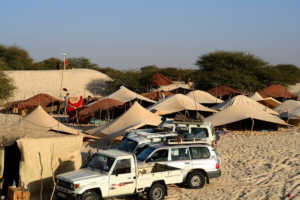Recently DreamWeaver Travel sponsored an 18-day trip to Bolivia and Peru, with the 2007 Alpaca Fiesta in Arequipa, Peru as it’s centerpiece. Trip dates were November 8-25. We had a group of 3 travelers plus Dudley for the first phase of the trip (Nov. 8-14) and 4 more folks joined us for the second phase (Nov. 15-25), beginning in Arequipa. I think we’d all agree that we owe a great deal of credit for the success of this adventure to our excellent guides, Wendy in Bolivia and Marco in Peru,
Starting out in La Paz, Bolivia, the highest capital city in the world, Suzie, Jerry, Susan, and I were met at the airport and transferred to the Plaza Hotel. Tired, but happy to be starting our adenture, we had a short orientation and hit the sack.
Next morning we had a great tour of La Paz , including the “witch’s market” and then an

excursion to the Valley of the Moon, including a great lunch at the Oberland Hotel in Mallaza on the plains above the valley in which La Paz is located. That evening we had dinner at a “Peña”, which is kind of like a dinner theatre, with traditional music and dance as the entertainment. Good food, good fun, great day!
On Day 3 we left La Paz and headed south for Sajama National Park and Tomarapi Ecolodge, where we checkd in and had lunch before heading back out to explore the countryside surrounding Mount Sajama where we were treated to the sight of many alpacas, llamas, vicuñas, and local and migratory birds for the remainder of the day. Dinner at the Tomarapi lodge consisted of local specialties such as quinoa soup, alpaca, good local bread, boiled corn, and chicha morada (a non-alcoholic corn drink).
The next day we got to witness an alpaca shearing at the farm of a member of the local alpaca cooperative. Shearing was by hand with knives and simple hand shears.

It was interesting to note that 4 years previously, shearing was done totally by knife and that hand shears was considered to be a very “high tech” improvement! After the shearing, we left for a long drive to the South to visit the ancient colored tombs near the village of Macaya. Then the long drive back to La Paz , dinner, and the comfort of our beds at the Plaza.
On Day 5 we visited the ruins of Tihuanaco on our way to Lake Titicaca.

The Tihuanaco ruins are famous as being the best example of ancient Aymara culture and the precursors to the Inca. The culture was thriving between 1580 BC and 1150 AD and was one of the most advanced societies of its time. We visited the extensive ruins and the wonderful museum on the grounds.
Then it was off to Taraco, on the nearest shore of Lake Titicaca, where we boarded our private launch to Pariti Island. Simple but tasty lunch on the way, visited the interesting museum on the Island, then on to Huatajata Harbor where we met our car and driver for the drive on to the wonderful Hotel Rosario del Lago in the center of beautiful little Copacabana.

That’s all for now – stayed tuned for more on the 2007 “Alpaca Roots” trip to Bolivia and Peru! We’re going again in October this year, with participation in the biggest vicuña roundup (chaccu) in South America as the centerpiece of the trip – and lots more!






















